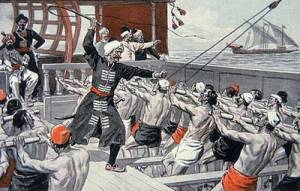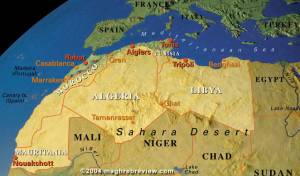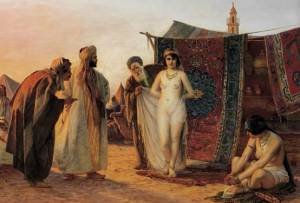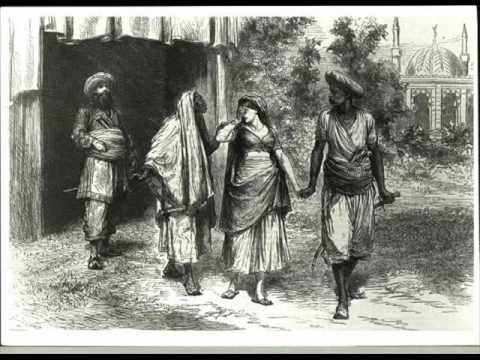I can hardly imagine why Dr. Norman Davies did not respond to my e-mail. I had written to him in Oxford, England after having completed his 1,200-page book on European history. I said nice words, of course, but I also gently asked why he had failed to make the slightest reference to the approximately 1.25 million Europeans (and 700 or so American sailors) who had been snatched and enslaved by the Barbary pirates of what are today Morocco, Algeria, Tunisia and Libya. If he could spend several pages  delving into the diplomatic maneuvers leading up to World War I, for example, why not acknowledge this awful era which ranged from the early 16th century up to the early 18th? Dr. Davies’ inexplicable omission is actually in line with most modern scholars who downplay or ignore it altogether. Their singular focus on the trans-Atlantic slave trade—and not for a moment would I deny its magnitude or horrors—is such that the idea of Africans enslaving Europeans seems inconceivable.
delving into the diplomatic maneuvers leading up to World War I, for example, why not acknowledge this awful era which ranged from the early 16th century up to the early 18th? Dr. Davies’ inexplicable omission is actually in line with most modern scholars who downplay or ignore it altogether. Their singular focus on the trans-Atlantic slave trade—and not for a moment would I deny its magnitude or horrors—is such that the idea of Africans enslaving Europeans seems inconceivable.
Rethinking the matter
Some historians make the fatal mistake of projecting the present onto the past and view the enslaved Europeans as pre-imperialists and their North African captors as proto-nationalists. I would suggest that it is time to rethink the matter and see it in a larger context.
In fact, the story began even earlier, with the overlords of the Ottoman Empire. Although not based in Africa, they assiduously sought European slaves. Greeks, Slavs and most of all blue-eyed Circassians were favored, and brought the highest prices in the slave markets of Constantinople from the 15th century onward.
The 770-year process of defeating and expelling the Moors from the Iberian Peninsula was completed in 1492. And where did they go? Most sailed south across the eight-mile Strait of Gibraltar to Morocco and spread throughout North Africa. These people were angry. Mohammedan theology holds that once they have taken a piece of land, it is theirs in perpetuity. Having been kicked out of Spain, they wanted nothing more than revenge against any and all Christians. Then having naval superiority and equipped with impressive firepower, they began to raid the ships of European nations in the Mediterranean. They sought booty as well as captives. Those poor men were put in irons and taken to the Maghreb—stretching from the Atlas Mountains of Morocco to Egypt’s western deserts—for what was a uniformly harrowing experience.
Haratin and bukhari
Let me take a moment to address the racial/ethnic issue. Virtually all of those who grabbed European sailors were Berbers or Arabs. Black people, those of sub-Saharan Africa, lived in the southern Maghreb  or in the Sahel, the semi-arid zone that goes from the Atlantic Ocean to the Red Sea and makes up modern-day Mauritania, Mali, Niger, Chad and Sudan. Known as haratin (a pejorative, meaning “dark color” or “plowmen”), they were long enslaved or at least held in low status. They survived—and still do—by accepting a subservient relationship to the Berbers and Arabs. While the haratin did not participate in enslaving these Europeans, they definitely aided and abetted the process. The sultan’s black guard, or bukhari, were haughty, fiercely loyal and often the hands-on masters of the European slaves. They took part in executions, torture and other forms of humiliation of their light-skinned enemies.
or in the Sahel, the semi-arid zone that goes from the Atlantic Ocean to the Red Sea and makes up modern-day Mauritania, Mali, Niger, Chad and Sudan. Known as haratin (a pejorative, meaning “dark color” or “plowmen”), they were long enslaved or at least held in low status. They survived—and still do—by accepting a subservient relationship to the Berbers and Arabs. While the haratin did not participate in enslaving these Europeans, they definitely aided and abetted the process. The sultan’s black guard, or bukhari, were haughty, fiercely loyal and often the hands-on masters of the European slaves. They took part in executions, torture and other forms of humiliation of their light-skinned enemies.
The North Africans raided far and wide. Spain, Italy, Sicily, Sardinia and Corsica were closest and got the worst of it. They also terrorized France, the Netherlands, Denmark, England, Ireland and even Iceland. Many coastal villages were destroyed (special attention was paid to desecrating churches) and depopulated. Consider the sad case of Baltimore in County Cork, at the southern tip of Ireland. On June 20, 1631, a dreaded band of Barbary corsairs came ashore. They were led, strangely enough, by a Dutchman, Jan Janszoon, who had apostasized and found that he enjoyed the life of a privateer. This fishing village was sacked, and almost everyone was taken. Many of Baltimore’s men were destined to live out their days as galley slaves, never again to set foot on land. Others were tossed into dungeons and did 15 hours of back-breaking work, seven days a week. Sultan Moulay Ismail’s huge palace complex in Meknes, Morocco was built entirely by European slave labor. The women spent long years in the harem, and the kids endured a hellish existence of their own. Baltimore was deserted for generations.
This scourge went on, as stated above, for three centuries; the slave markets in Tunis, Algiers, Tripoli and Sale thrived. Occasionally there were outcries in Europe. Some prominent people were ransomed, and a few hardy souls escaped and found their way back home.
Jefferson says, “No more”
Only gradually did it come to an end. The Berbers made the mistake of capturing some U.S. vessels and taking several hundred American sailors hostage. Tribute was paid to Omar Agha, the Dey of Algiers, in 1800, but this rankled President-elect Thomas Jefferson. Some American crews had been enslaved for  more than a decade when he said enough was enough. The thought of American men in chains and irons being driven by whip-wielding infidels infuriated him and others. Jefferson sent a number of well-armed ships to Tripoli to force the matter. The two Battles of Barbary were indicative of change. Then came the Bombardment of Algiers by Britain and the Netherlands (1816) which freed some 3,000 slaves. The Dey reluctantly signed a treaty stating that the taking of European and American slaves would end, but compliance was delayed until the French conquered Algeria in 1847.
more than a decade when he said enough was enough. The thought of American men in chains and irons being driven by whip-wielding infidels infuriated him and others. Jefferson sent a number of well-armed ships to Tripoli to force the matter. The two Battles of Barbary were indicative of change. Then came the Bombardment of Algiers by Britain and the Netherlands (1816) which freed some 3,000 slaves. The Dey reluctantly signed a treaty stating that the taking of European and American slaves would end, but compliance was delayed until the French conquered Algeria in 1847.
I am pleased to know that my people, people of European descent, were finally freed from the yoke of the Arabs and Berbers, but what of those other Africans, descendants of the haratin? Their value is surely no less. They remain subject to oppression by people who consider themselves superior. This is called racism or at least ethnocentrism, something to which we are all subject but we strive to overcome. Slavery was not outlawed in the Ottoman Empire until 1871 and not until 1962 (!) in Saudi Arabia, birthplace of Mohammedanism. It happened for one reason: pressure from the West. Even today, there are reports of foreigners (Filipinos, Indonesians, Indians, Sri Lankans, Bangladeshis, Eritreans, Ethiopians and Kenyans) being held in slave-like conditions in the so-called kingdom. Just as modern historians—hello, Dr. Davies—have been suspiciously quiet about Arabs and Berbers enslaving Europeans for 300 years, they shy away from addressing what those same people have done to sub-Saharan Africans. It’s been going on since the 7th century, for God’s sake.

